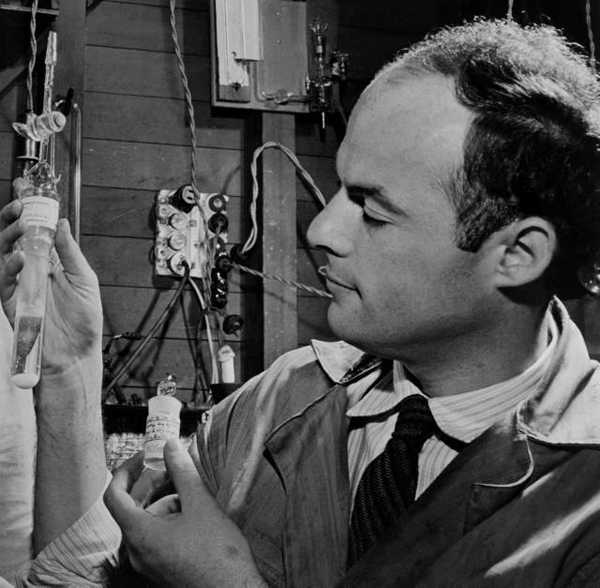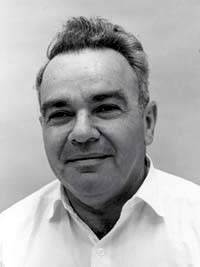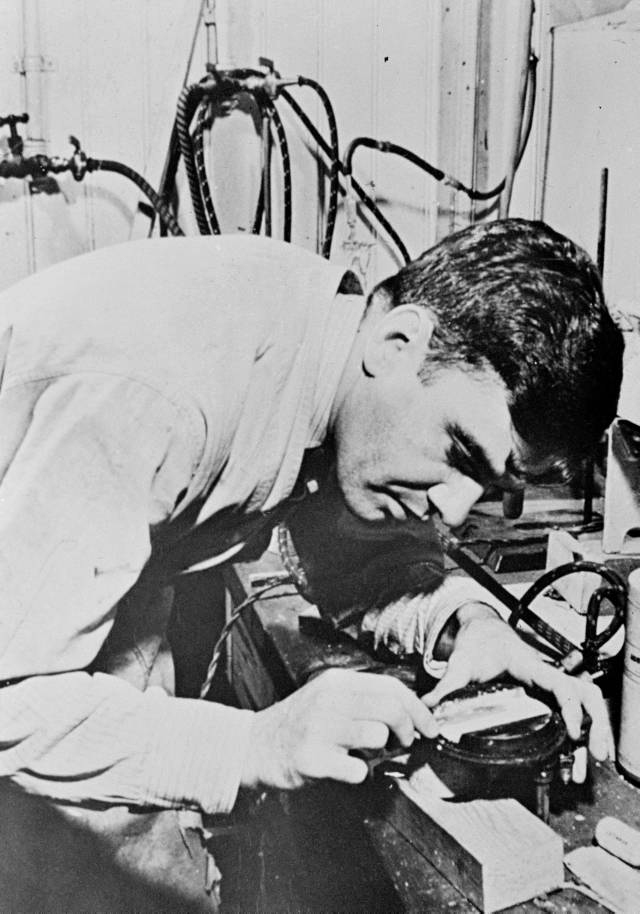<Back to Index>
- Physical Chemist and Biochemist Samuel Ruben (Charles Rubenstein), 1913
- Physical Chemist Martin David Kamen, 1913
PAGE SPONSOR

Samuel Ruben (born Charles Rubenstein, November 5, 1913 – September 28, 1943), the son of Herschel and Frieda Penn Rubenstein – the name was officially shortened to Ruben in 1930. Young Sam developed a friendship with neighbor Jack Dempsey and became involved with a local boys' boxing club and later, when the family moved across the Bay to Berkeley, he was a successful basketball player at Berkeley High School (Berkeley, California). After achieving his B.S. in Chemistry at the University of California, Berkeley, he continued his studies there and was awarded a Ph.D. in Physical Chemistry in May 1938. He was immediately appointed Instructor in the Chemistry Department, and became an Assistant Professor in 1941.
Sam and colleague Martin Kamen, a University of Chicago Ph.D. and researcher in chemistry and nuclear physics working under Ernest O. Lawrence at the Berkeley Radiation Laboratory, set out to elucidate the path of carbon in photosynthesis by incorporating the short lived radioactive isotope Carbon-11 (11CO2) in their many experiments between 1938 and 1942. Aided by the concepts and collaboration of C.B. van Niel, at Stanford University’s Hopkins Marine Station, it became clear to them that reduction of CO2 can occur in the dark and may involve processes similar to bacterial systems. This interpretation challenged the century old Adolf von Baeyer theory of photochemical reduction of CO2 adsorbed on chlorophyll which had guided decades of effort by Richard Willstätter, A. Stoll, and many others in vain searches for formaldehyde.
In hundreds of experiments with Carbon-11 produced from deuterons and Boron-10 by Martin Kamen in the Radiation Laboratory’s 37-inch cyclotron, Ruben and Kamen, with collaborators from botany, microbiology, physiology and organic chemistry, pursued the path of carbon dioxide in plants, algae, and bacteria. Their results, confused by absorption of the products on proteinaceous residues, initially failed to reveal the path of carbon in photosynthesis but succeeded in exciting the interest of scientists worldwide in the search and revelation of metabolic processes, beginning a revolution in biochemistry and medicine.
Ruben’s experiments using 'heavy water', H2O18, to yield 18O2 gas had shown that the oxygen gas produced in photosynthesis comes from water. With nuclear physicists' tenuous prediction of a "long lived radioactive carbon isotope,” Ruben and Kamen pursued several routes that could lead to identification of the Carbon-14 isotope. After several failed attempts, Martin Kamen collected the results of a 120 hour cyclotron bombardment of graphite and trudged in the rain with it to the “Rat House,” adjacent both to the Chemistry Department and to the cyclotron, and Sam Ruben's desk. At 8 AM, February 27, 1940, Sam Ruben demonstrated unequivocally the radioactivity was from Carbon-14.
The weak energy of Carbon-14 made measurement tedious. So tedious that no tracer experiments with C-14 were done until 1942 when Sam Ruben gave all his barium carbonate-C14 to young Chemistry Department faculty member Andrew Benson who began his long series of 14CO2 fixation experiments to determine the path of carbon in photosynthesis. Only in 1949 did chemist Willard Libby use it to invent radiocarbon dating.
Ruben's recruitment for research in the World War II wartime effort led him to interest in the mechanism of phosgene as a poisonous gas. With C-11 phosgene (11COCl2) prepared by Benson, they studied the combination of phosgene with lung proteins. Following Benson's departure from Berkeley in July 1943, Ruben died September 28, 1943 after a disastrous exposure to phosgene in a laboratory accident the preceding day.
Sam
Ruben married Helena Collins West, a fellow chemistry student, during
his final semester as an undergraduate at UC Berkeley, on September 28,
1935. They had three children, Dana West Ruben (born November 11, 1938),
George Collins Ruben (born April 29, 1941), and Connie Mae Ruben Fatt
(born June 18, 1943).


Martin David Kamen (August 27, 1913, Toronto – August 31, 2002), a physicist inside the Manhattan project. Together with Sam Ruben, he co-discovered the isotope carbon-14 on February 27, 1940, at the University of California Radiation Laboratory, Berkeley.
Kamen was born August 27, 1913, in Toronto, the son of Russian immigrants. He grew up in Chicago. He received a bachelor's degree in chemistry from the University of Chicago in 1933 and obtained a PhD in physical chemistry from the same university in 1936. Thereafter he sought a research position in chemistry and nuclear physics under Ernest Lawrence at the radiation laboratory in Berkeley, where he worked without pay for six months until being hired to oversee the preparation and distribution of the cyclotron's products. The discovery of carbon-14 occurred at Berkeley when Kamen and Ruben bombarded graphite in the cyclotron in hopes of producing a radioactive isotope of carbon that could be used as a tracer in investigating chemical reactions in photosynthesis. Their experiment resulted in production of carbon-14.
In 1943, Kamen was assigned to Manhattan Project work at Oak Ridge, Tennessee, where he worked briefly before returning to Berkeley. He was fired from Berkeley in 1945 after being accused of leaking nuclear weapons secrets to Russia, and for a time was unable to obtain an academic position, until being hired by Arthur Holly Compton to run the cyclotron program in the medical school of Washington University at St. Louis. Kamen taught the faculty how to use radioactive tracer materials in research, and his own interests gradually shifted into biochemistry.
In 1957, he moved to Brandeis University in Massachusetts, and in 1961 he joined the University of California, San Diego, where he remained until his retirement in 1978.
Martin Kamen died August 31, 2002, at the age of 89 in Montecito (Santa Barbara) Calif and he was a long time resident of Casa Dorinda retirement home. He was very well liked and admired for helping others.
By bombarding matter with particles in the cyclotron,
radioactive isotopes such as carbon-14, were generated. Using
carbon-14, the order of events in biochemical reactions could be
elucidated, showing the precursors of a particular biochemical product,
revealing the network of reactions that constitute life. Kamen is
credited with confirming that all of the oxygen released in photosynthesis comes from water, not carbon dioxide. He also studied the role of molybdenum in biological nitrogen fixation, the biochemistry of cytochromes and their in photosynthesis and metabolism, the role of iron in the activity of porphyrin compounds in plants and animals, and calcium exchange in cancerous tumors.
Kamen was a target and victim of American anti - communist fervor in the 1940s and 1950s. He described his experiences during this era in his autobiography, Radiant Science, Dark Politics. He first aroused suspicion while working at Oak Ridge. A cyclotron operator prepared radioactive sodium for an experiment, and Kamen was surprised that the resulting sodium had a purple glow, indicating it was much more intensely radioactive than could be produced in a cyclotron. Kamen recognized immediately that the sodium must have been irradiated in a nuclear reactor elsewhere in the facility. Because of wartime secrecy, he had not been aware of the reactor's existence. He excitedly told his colleagues about his discovery. Shortly thereafter, an investigation was launched to find out who had leaked the information to Kamen.
After returning to Berkeley, Kamen met two Russian officials at a party given by his friend, the violinist Isaac Stern, whom he sometimes accompanied as a viola player in social evenings of chamber music. The Russians were Grigory Kheifets and Grigory Kasparov, posted as undercover KGB officers in the Soviet Union's San Francisco consulate. One of them asked Kamen for assistance in getting experimental radiation treatment for a colleague with leukemia. Kamen made inquiries, and in appreciation the official invited him for dinner at a local restaurant. In the aftermath of the Oak Ridge incident, Kamen was under continuing surveillance by FBI agents who observed the July 1, 1944 dinner, where Kamen was alleged to have discussed atomic research with Kheifets. Kamen lost his Berkeley position shortly afterwards.
The House Committee on Un-American Activities summoned Kamen to testify in 1948. A Congressional investigation established that Kheifets had received classified information from Kamen concerning uranium stockpiles. Subsequently the State Department refused to issue him a passport. In 1951 the Chicago Tribune named him as a suspected spy. Kamen attempted suicide. After a 10 year effort to establish his innocence and prove that he had been blacklisted as a security risk, he won a libel suit against the Tribune in 1955 and was able once again to obtain a passport.
Some time during the 1980s, Kamen became a member of the "faculty" at the Oregon Institute of Science and Medicine, the think tank which was responsible for the controversial Oregon Petition. The purpose of this petition was to show a lack of consensus among scientists on the subject of global warming. The text accompanying the petition has since come under attack for being deceptively written.
Winner of the Enrico Fermi Award April 24, 1996. He was awarded the 1989 Albert Einstein World Award of Science.